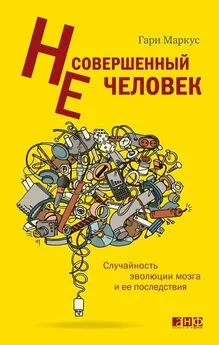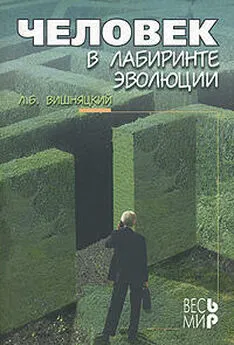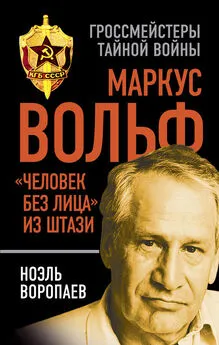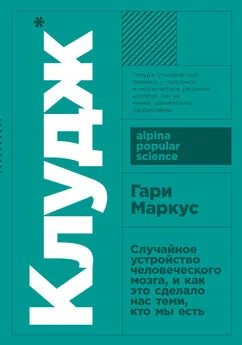Гари Маркус - Несовершенный человек. Случайность эволюции мозга и ее последствия.
- Название:Несовершенный человек. Случайность эволюции мозга и ее последствия.
- Автор:
- Жанр:
- Издательство:Альпина нон-фикшн
- Год:2011
- Город:Москва
- ISBN:978-5-91671-085-4
- Рейтинг:
- Избранное:Добавить в избранное
-
Отзывы:
-
Ваша оценка:
Гари Маркус - Несовершенный человек. Случайность эволюции мозга и ее последствия. краткое содержание
Человек привык считать себя венцом творения: свои сильные стороны – нормой, а слабости – отклонением. Подход автора принципиально другой: мы изначально несовершенны; наш мозг, как и тело, в ходе эволюции формировался достаточно случайно, из «подручных материалов» природы и являет собой так называемый клудж – нелепое, неуклюжее, но удивительно эффективное решение проблемы. Понятие клуджа проливает свет на важные стороны нашей жизни и объясняет множество проблем, с которыми мы сталкиваемся. Выводы автора оптимистичны: имея должное понимание соотношения сил и слабостей человеческого ума, мы получаем возможность помочь не только себе, но и обществу.
Несовершенный человек. Случайность эволюции мозга и ее последствия. - читать онлайн бесплатно ознакомительный отрывок
Интервал:
Закладка:
Plomin, R., DeFries, J.C, McClearn, G.E., & McGuffin, P.(2001). Behavior genetics. New York: Worth.
Polimeni, J., & Reiss, J.P.(2002). How shamanism and group selection may reveal the origins of schizophrenia. Medical Hypotheses, 58(3), 244-48.
Posner, M.I., & Keele, S.W.(1968). On the genesis of abstract ideas. Journal of Experimental Psychology, 77(3), 353-63.
Prasada, S.(2000). Acquiring generic knowledge. Trends in Cognitive Sciences, 4, 66-72.
Premack, D.(2004). Psychology: Is language the key to human intelligence? Science, 303(5656), 318-320.
Price, J., Sloman, L., Russell Gardner, J., Gilbert, P., & Rohde, P.(1997). The social competition hypothesis of depression. In S. Baron-Cohen (Ed.), The maladapted mind: Classic readings in evolutionary psychopathology (pp. 241-54). Hove, UK: Psychology Press.
Pullum, G.K.(1991). The great Eskimo vocabulary hoax and other irreverent essays on the study of language. Chicago: University of Chicago Press.
Quattrone, G.A., & Tversky, A.(1988). Contrasting rational and psychological analyses of political choice. American Political Science Review , 82, 719-36.
Rachlin, H.(2000). The science of self-control. Cambridge, MA: Harvard University Press.
Read, D., & van Leeuwen, B.(1998). Predicting hunger: The effects of appetite and delay on choice. Organizational Behavior and Human Decision Processes, 76(2), 189-205.
Reder, L.M., & Kusbit, G.W.(1991). Locus of the Moses illusion: Imperfect encoding, retrieval, or match. Journal of Memory and Language, 30, 385-406.
Robinson, T.N., Borzekowski, D.L.G., Matheson, D.M., & Kraemer, H.C.(2007). Effects of fast-food branding on young children's taste preferences. Archives of Pediatrics and Adolescent Medicine, 161(8), 792.
Rosa-Molinar, E., Krumlauf, R.K., & Pritz, M.B.(2005). Hindbrain development and evolution: Past, present, and future. Brain, Behavior, and Evolution, 66(4), 219-21.
Ross, M., & Sicoly, F.(1979). Egocentric biases in availability and attribution. Journal of Personality and Social Psychology, 37(3).
Russell, B.(1918/1985). The philosophy of logical atomism. Lasalle, IL: Open Court.
Russo, J.E., & Schoemaker, P.J.H.(1989). Decision traps: Ten barriers to brilliant decision-making and how to overcome them (1st ed.). New York: Doubleday/Currency.
Schacter, D.L.(2001). The seven sins of memory: How the mind forgets and remembers. Boston: Houghton Mifflin.
Schacter, D.L., & Addis, D.R.(2007). Constructive memory: The ghosts of past and future. Nature, 445(7123), 27.
Schelling, T.C.(1984). Choice and consequence. Cambridge, MA: Harvard University Press.
Schooler, J.W., Reichle, E.D., & Halpern, D.V.(2004). Zoning out while reading: Evidence for dissociations between experience and metaconsciousness. In Thinking and seeing: Visual metacognition in adults and children (pp. 203-206). Cambridge, MA: MIT Press.
Schwartz, В., & Schwartz, B.(2004). Paradox of choice: Why more is less. New York: HarperCollins.
Schwarz, N., Strack, E., & Mai, H.P.(1991). Assimilation and contrast effects in part-whole question sequences: A conversational logic analysis. Public Opinion Quarterly, 55(1), 3-23.
Sherman, J.W., Macrae, C.N., & Bodenhausen, G.V.(2000). Attention and stereotyping: Cognitive constraints on the construction of meaningful social impressions. European Review of Social Psychology, 11, 145-175.
Shiv, В., & Fedorikhin, A.(1999). Heart and mind in conflict: The interplay of affect and cognition in consumer decision making. Journal of Consumer Research, 26(3), 278.
Simon, L., Greenberg, J., Harmon-Jones, E., Solomon, S., Pyszczynski, Т., Arndt, J., & Abend, T.(1997). Terror management and cognitive experiential self-theory: Evidence that terror management occurs in the experiential system. Personality and Social Psychology, 72(5), 1132-46.
Simons, D.J., & Levin, D.T.(1998). Failure to detect changes to people during a real-world interaction. Psychonomic Bulletin and Review, 5(4), 644-49.
Smith, D.M., Schwarz, N., Roberts, T.R, & Ubel, P.A.(2006). Why are you calling me? How study introductions change response patterns. Quality of Life Research, 15(4), 621-30.
Smolin, L.(2006). The trouble with physics: The rise of string theory, the fall of a science, and what comes next. Boston: Houghton Mifflin.
Solomon, S., Greenberg, J., & Pyszczynski, T.(2004). The cultural animal: Twenty years of terror-management theory and research. Handbook of Experimental Existential Psychology, 13-34.
Solon, T.(2003). Teaching critical thinking! The more, the better. The Community College Experience, 9(2), 25-38.
Stanovich, K.E.(2003). The fundamental computational biases of human cognition: Heuristics that (sometimes) impair decision making and problem solving. In J.E. Davidson & R.J. Sternberg(Eds.), The psychology of problem solving (pp. 291-342). New York: Cambridge University Press.
Steel, P.(2007). The nature of procrastination: A meta-analytic and theoretical review of quintessential self-regulatory failure. Psychological Bulletin , 133(1), 65-94.
Steele, С.M., & Aronson, J.(1995). Stereotype threat and the intellectual test performance of African Americans. Journal of Personality and Social Psychology 69(5), 797-811.
Stich, S.(in press). Nicod lectures on morality. Cambridge, MA: MIT Press. Videos available at:
http://semioweb.msh-paris.fr/AR/974/liste_conf.asp.
Strack, R., Martin, L.L., & Schwarz, N.(1988). Priming and communication: Social determinants of information use in judgments of life satisfaction. European Journal of Social Psychology, 28(5), 429-42.
Strack, R., Martin, L.L., & Stepper, S.(1988). Inhibiting and facilitating conditions of the human smile: A nonobtrusive test of the facial feedback hypothesis. Journal of Personality and Social Psychology, 54(5), 768-77.
Svenson, O.(1981). Are we all less risky and more skillful than our fellow drivers ? Act a Psychologica, 47(2), 143-218.
Takahashi, T.(2005). The evolutionary origins of vertebrate midbrain and MHB: Insights from mouse, amphioxus and ascidian Dmbx homeobox genes. Brain Research Bulletin, 66(4-6), 510-17.
Talarico, J.M., & Rubin, D.C.(2003). Confidence, not consistency, characterizes flash-bulb memories. Psychological Science, 14(5), 455-61.
Tetlock, P.E.(1985). Accountability: A social check on the fundamental attribution error. Social Psychology Quarterly, 48(3), 227-36.
Thaler, R.H.(1999). Mental accounting matters. Journal of Behavioral Decision Making , 12(3), 183-206.
Thompson, C.(2007). Halo 3: How Microsoft labs invented a new science of play. Wired , 15,140-47.
Thomson, J.J.(1985). The trolley problem. Yale Law Journal, 94(6), 1395-1415.
Todorov, A., Mandisodza, A.N, Goren, A., & Hall, С.C.(2005). Inferences of competence from faces predict election outcomes. Science, 308(5728), 1623-6.
Tooby, J., & Cosmides, L.(1995). Mapping the evolved functional organization of mind and brain. In M.S. Gazzaniga(Ed.), The cognitive neurosciences (pp. 1185-97). Cambridge, MA: MIT Press.
Topping, K.J., & Trickey, S.(2007). Collaborative philosophical enquiry for school children: Cognitive effects at 1012 years. British Journal of Educational Psychology, 77(2), 271-88.
Trehub, S.(2003). Musical predispositions in infancy: An update. In I. Peretz & R.J. Zattore(Eds.), The cognitive neuroscience of music (pp. 3-20). New York: Oxford University Press.
Trivers, R.(1972). Parental investment and sexual selection. Oxford, UK: Oxford University Press.
Tuchman, B.(1984). The march of folly: From Troy to Vietnam (1st ed.). New York: Knopf.
Tulving, E., & Craik, E.L.M.(2000). The Oxford handbook of memory. New York: Oxford University Press.
Tversky, A., & Kahneman, D.(1974). Judgment under uncertainty: Heuristics and biases. Science, 185(4157), 1124-31.
Tversky, A., & Kahneman, D.(1981). The framing of decisions and the psychology of choice. Science, 211(4481), 453-8.
Tyre, P.(2004, June 7). Clean freaks. Newsweek. U.S. Department of Labor Statistics. (2007, June 28). American time use survey summary. From:
http://www.bls.gov/news.release/atus.nro.htm.
Wansink, В., Kent, R.J., & Hoch, S.J.(1998). An anchoring and adjustment model of purchase quantity decisions. Journal of Marketing Research, 35(1), 71-81.
Wason, P.C.(1960). On the failure to eliminate hypotheses in a conceptual task. Quarterly Journal of Experimental Psychology , 12,129-40.
Watkins, P.C, Vache, K., Verney, S.P., Muller, S., & Mathews, A.(1996). Unconscious mood-congruent memory bias in depression. Journal of Abnormal Psychology , 105(1), 34-41.
Wegner, D.M.(1994). Ironic processes of mental control. Psychological Review , 101(1), 34-52.
Weiner, J.(1994). The beak of the finch: A story of evolution in our time (1st Vintage Books ed.). New York: Vintage Books.
Wesson, R.G.(1991). Beyond natural selection. Cambridge, MA: MIT Press.
Williams, W.M., Blythe, T., White, N., Li, J., Gardner, H., & Sternberg, R.J.(2002). Practical intelligence for school: Developing metacognitive sources of achievement in adolescence. Developmental Review , 22(2), 162-210.
Wilson, T.D., & Brekke, N.(1994). Mental contamination and mental correction: Unwanted influences on judgments and evaluations. Psychological Bulletin , 116(1), 117-42.
Winkielman, P., & C. Berridge, K.(2004). Unconscious emotion. Current Directions in Psychological Science, 13(3), 120-3.
Zajonc, R.В.(1968). Attitudinal effects of mere exposure. Journal of Personality and Social Psychology, 9(2, Pt. 2), 1-27.
Zimmer, C.(2004). Soul made flesh: The discovery of the brain – and how it changed the world. New York: Free Press.
Примечания
1
Понятие байесовской вероятности происходит от математической теоремы, выведенной из работ Реверенда Томаса Байеса (1702-1761), хотя сам он не предлагал ее как модель человеческого мышления. Грубо говоря, теорема утверждает, что возможность некоего события зависит от его правдоподобия и осуществимости.
Читать дальшеИнтервал:
Закладка:









